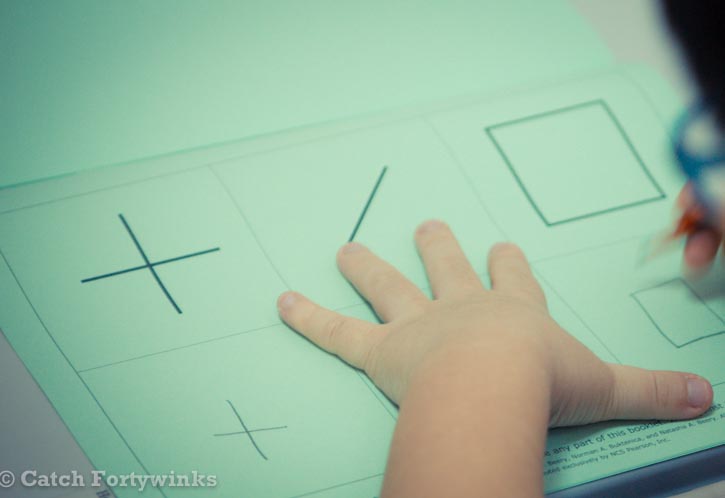Read here for Part 1 of BrainFit Studio A Review
K underwent a 2 hour Cognitive Assessement test at BrainFit Studio to determine his cognitive profiling of his 4 brain pillars of Visual, Auditory, Sensory-Motor and Attention-Memory. So how did he fare?
The assessments in BrainFit’s COGNITIVEMAP assessment test use standardized tests that are tried and tested on large sample of age-equivalent children. Usually, a standard score will range between 85-115 and the results are an approximation of the child’s abilities.
1. Visual

Results : –
i) Non Verbal IQ evaluates his ability to solve new problems by assessing his ability to perceive relationships and complete visual analogies. K’s score at 114 is at a high average
ii) His Visual Sequential Memory, which is his ability to remember the sequence of a series of forms, is above average. I was rather surprisde to see a high average score for this, as I used to think he has a bad memory for a 6 year old, hardly recalls what I tell him!
iii) Visual Motor Integration is the ability to co-ordinate his visual perception skills with his fingers and hands. He was able to draw quite a number of visual patterns quite accurately, even as the patterns became more difficult as he continued in the activity. This could be a result of taking art classes the last 6 months, which I think have been crucial in helping him to improve his overall visual skills.
iv) Eye Control Relative Speed and Accuracy measures the skills required for reading tasks. His eye control is high above average, however accuracy can be further improved. Nonetheless, this is a heartening point for me, as this is an indication that there is definitely hope that his lazy eye condition will continue to improve over time!
2. Auditory

i) Verbal IQ evaluates his word knowledge, general IQ, verbal concept and reasoning ability, his scores were a high average
ii) Fluency of recognition of numbers is high
iii) Phonological Skills, Auditory Memory is low, and Phonological Blending is low on average. I didn’t think this was much of a concern since K is able to read English chapter books fluently. As I sat in throughout the full session of the assessment tests, I found the Phonological skills and blending tests very tough, I couldn’t get the right answers to the questions either!

From these auditory skills assessments, I discovered that his problem was not being able to hear or understand the instructions, but he practices selective listening as he can get easily distracted, which affects his auditory and visual attention spans.
3. Motor

Results : –
i) Manual Dexterity or measurement of his Fine Motor Skills scores is low. Manual Dexterity also gives an indication of body and spatial awareness, which activates the Parietal Lobe in the brain. The Parietal Lobe plays an important role in integrating sensory information from various parts of the body, and it is also involved in symbolic functions in language (especially Chinese characters and Mathematics!!)
ii) Aiming and Catching – K is weak at catching the beanbag, however he has very high accuracy in aiming when he threw the beanbag onto the map. This balanced the test scores to an average for this activity.
iii) Balance – K’s balance is generally poor.
K have showed his strengths in his gross motor skills with his experience in racquet sports at a very tender age, and I am aware that male children generally tend to be slower in fine motor skills development in comparison to female children. However, his previous motor skill development reports from preschool have showed that he does have some issues with balance and he is unable to catch things well (butter-fingers?!?). I am wondering if this is related to his short-fall in his visual depth perception skills? Which is an apparent problem with lazy eye conditions.
4. Attention

Results : –
The feedback that i got from the Brainfit consultant for these results were that K was not impulsive child, who will not ‘act before thinking’. He did not pre-empt the actions from the computer programme, and reacted in tune with the ‘right’ visual and auditory stimuli. The only issue he had was a tendency to miss the visual cues during the evaluation, as he tends to get distracted over longer periods and will become rather fidgety.
I had the impression that K had bad impulse control, so the results from this segment of tests surprised me. As for the part about being distracted and fidgety, that was not a surprise, since I often say this to him, “Do you have ants in your pants?

Brain Fitness Programme Selected
Based on K’s cognitive profile, Brainfit programme consultant Ai Min recommended K attends a total of 80 sessions of classes, which was a combination from each of the specific brain pillars. Read here for the various types of programmes BrainFit offers; SMART Moves, SMART Vision, SMART Listening, SMART Focus, SMART EQ.
Since BrainFit have kindly sponsored 20 sessions of classes for the purpose of this review, I decided to focus on one specific pillar that I felt he had the most short-fall, Sensory-Motor. Instead of experiencing a mix of classes in this 20 sessions for a combination of brain pillars. By taking this approach, I am sure the results from the post-evaluation Cognitive Assessment Test will be more indicative of the progress made from his Sensory-Motor brain pillar.
The other reason why I chose Sensory-Motor pillar, is that I have been intrigued by research done on the brain’s Parietal Lobe. Where it has been written that the Parietal lobe is a core part of the brain that is utilized in reading Chinese characters, and if an individual experienced deficiencies, it will be a cause for difficulties in Math.
Let me put this in simpler terms :

His chinese definitely needs ALOT of help. And I am now even more intrigued to find out if 20 sessions of SMART Moves from Brainfit Studio will help him to exercise his Parietal lobe in his brain. In turn, improving his focus, coordination and fine motor skills, and maybe, even improve his propensity to learn Chinese and Math!
So look out for next post on my review of BrainFit Studio in the next 10 weeks to find out what K did in his SMART Moves programme, as well as the final outcome of the 20 sessions.
Location of BrainFit Centres :
BrainFit Studio, Novena : 193 – 197 Thomson Road Goldhill Centre Singapore 307633 Tel: 6737 3511 Fax: 6737 4533
BrainFit Studio, East : 83, East Coast Road Singapore 428786 Tel: 6346 4386
BrainFit Studio, Serangoon Garden : 74 & 74A Serangoon Garden Way Singapore 555970 Tel : 6281 1343
Disclosure : I was sponsored CognitiveMap Assessment by Brainfit for the purpose of this review. Results of the assessment tests shared in this post are from a cognitive profiling assessment report of K provided by Brainfit Studios, but all opinions are my own.
 This test measured K’s ability to remember the sequence of a series of forms.
This test measured K’s ability to remember the sequence of a series of forms.


























